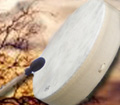Welcome
All cultures around the world have embraced the drum at some point in their history for healing, meditation, sacred ritual and for connecting with the Divine. Frame drums are some of the oldest musical instruments, and there is evidence of ritual shamanic use as early as the Paleolithic Era. A revered and sacred tool of priestesses and holy men, indigenous shamans, nomadic and tribal communities, the use of the drum today for its ceremonial, spiritual, healing and therapeutic benefits has not changed a great deal since the time of the earliest civilisations.
A revered and sacred tool of priestesses and holy men, indigenous shamans, nomadic and tribal communities, the use of the drum today for its ceremonial, spiritual, healing and therapeutic benefits has not changed a great deal since the time of the earliest civilisations.
Reiki is a system of natural healing which has also been in use for
many thousands of years. Rei-Ki means spiritual energy or universal
life-force energy. At an atomic level everything which exists in the
Universe is made up of energy vibrating at different rates. Humans are
also comprised of electromagnetic energy and in healing Reiki acts
holistically, affecting all the energies comprising the human body,
physically,
emotionally, mentally and spiritually. Reiki is non invasive and has been shown to effectively stimulate the relaxation response.
been shown to effectively stimulate the relaxation response.
Combining Reiki and Drumming creates the Reiki Drum Technique, a method of utilising the drum to introduce Reiki energy into a person’s energy field to bring about deep relaxation thereby releasing deep seated tensions and achieving homeostasis. The drum rhythm reminds the body of its optimal vibration.
There have been many scientific research studies conducted to discover the effect sound and drumming have on the human body and psyche. Research has indicated that even drumming for a short period of time can induce an alpha state, brainwaves associated with wellbeing and euphoria. Drumming helps people express and address emotional issues, aiding in the removal of blockages and producing emotional release. Studies have linked drumming with positive effects on Alzheimer’s and Dementia patients, emotionally disturbed teens, recovery addicts and trauma patients.


